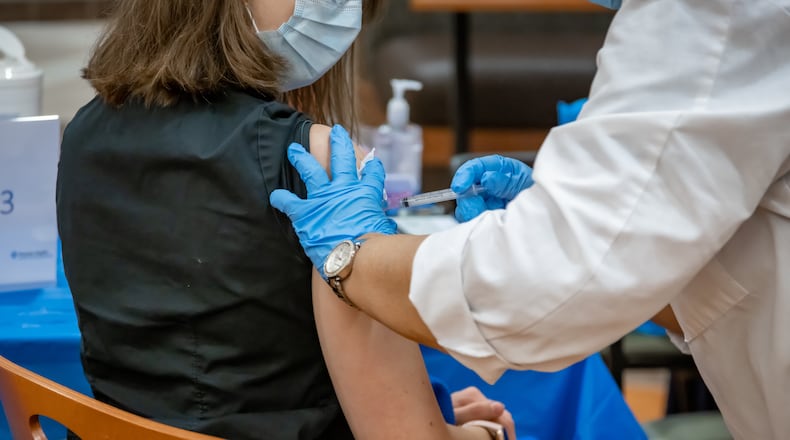“We can’t control how fast the vaccine comes into the state of Ohio and we know there’s a scarcity,” DeWine said. “... We certainly can control how fast that we get it out and that is incumbent upon all of us Ohioans … there’s a moral imperative to get this out, just as quickly as we can ... We’re not moving fast enough but we’re going to get there and we’re going to we’re going to speed this thing up.”
DeWine resisted blaming any specific entities involved with distribution — hospitals, health departments and pharmacies — and said this is an unprecedented undertaking. He beseeched them and individuals to take certain steps.
DeWine set a goal for Ohio hospitals to give out vaccine doses within 24 hours of receiving them whenever possible. Some hospitals are moving quickly and others are not, he said.
According to numbers released by hospital systems and the department of health, Montgomery County has received over 18,800 vaccine doses in the last two weeks and distributed about 4,000 doses, according to the Ohio Department of Health.
Kettering Health Network has six vaccination sites to distribute the approximately 7,500 doses the hospital system has received in the last two weeks, said a spokeswoman.
Premier Health Network has received 6,900 doses of COVID-19 vaccine and as of Tuesday had administered more than 2,200 doses, according to a spokesman. The hospital system is on pace to administer approximately 2,000 doses per week and all doses received last week are scheduled or available to be administered by Jan. 9, according to an emailed statement.
Springfield Regional Medical Center in Clark County has received around 2,500 doses and distributed about half of them so far, according to a spokeswoman.
DeWine also pleaded that Ohioans in the Phase 1A group to get vaccinated.
“First of all, this is your choice,” he said. “We believe that medical science clearly shows that it’s the right thing to do ...The gain far exceeds the risk ... listen to the health professionals in regard to that.”
Only about 40% of Ohio nursing home staff are choosing to get vaccinated, according to DeWine. He cautioned members of group 1A that if they pass up the opportunity to get vaccinated now, they may not have another chance soon.
Ohio’s congregate living facilities such as nursing homes are largely receiving their vaccines from a federal partnership with retail pharmacies. In this program, a pharmacy will visit a facility on three separate days to give both doses to any staff and residents who want the shot. If an individual passes on the first dose on the second visit, the state can’t guarantee when they will get the second dose, DeWine said.
DeWine announced the following vaccine shipments are coming to the state next week:
- 69,500 doses from Moderna
- 70,200 first doses from Pfizer
- 98,475 doses from Pfizer allocated for second doses
Curfew extended
Also announced Wednesday, the Ohio Department of Health extended its 10 p.m. to 5 a.m. curfew another three weeks until Jan. 23. The curfew does not apply to Ohioans going to work, shopping for groceries or who have an emergency or medical need. DeWine said the extension is in-part so communities can determine if they will see a post-holiday case surge that impacts hospitals.
School quarantine
Meanwhile, K-12 schools received updated guidance from the state on quarantining. It is no longer recommended that school students and staff who have been exposed to another COVID-positive individual in the classroom must quarantine. Schools are advised to continue quarantining exposed students and staff if masking and distancing protocols were not followed or if the exposure happened during an after-school activity, including sports.
“...Experts believe (school) is the best place for most of our kids to learn and socialize,” DeWine said. “It’s critical that we ensure our students and staff returned to school safely.”
The state guidance was updated based on data collected by the Ohio Schools COVID-19 Evaluation Team and another report from Mississippi that was recently highlighted by the Centers for Disease Control. The Ohio study involved the testing of 728 children in seven school districts between Nov. 10 and Dec. 18.
The study found that as long as students in the classroom wore masks and complied with social distancing, they had no increased risk of catching COVID-19 from a nearby student compared with students further away in the same classroom or in the same grade outside that classroom, explained Dr. Bruce Vanderhoff, Ohio Department of Health chief medical officer.
The Ohio Department of Health reported 8,178 coronavirus cases, 366 hospitalizations and 133 deaths from the virus on Wednesday.
About the Author

